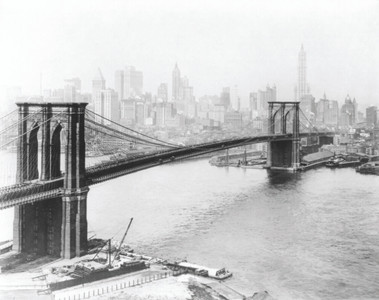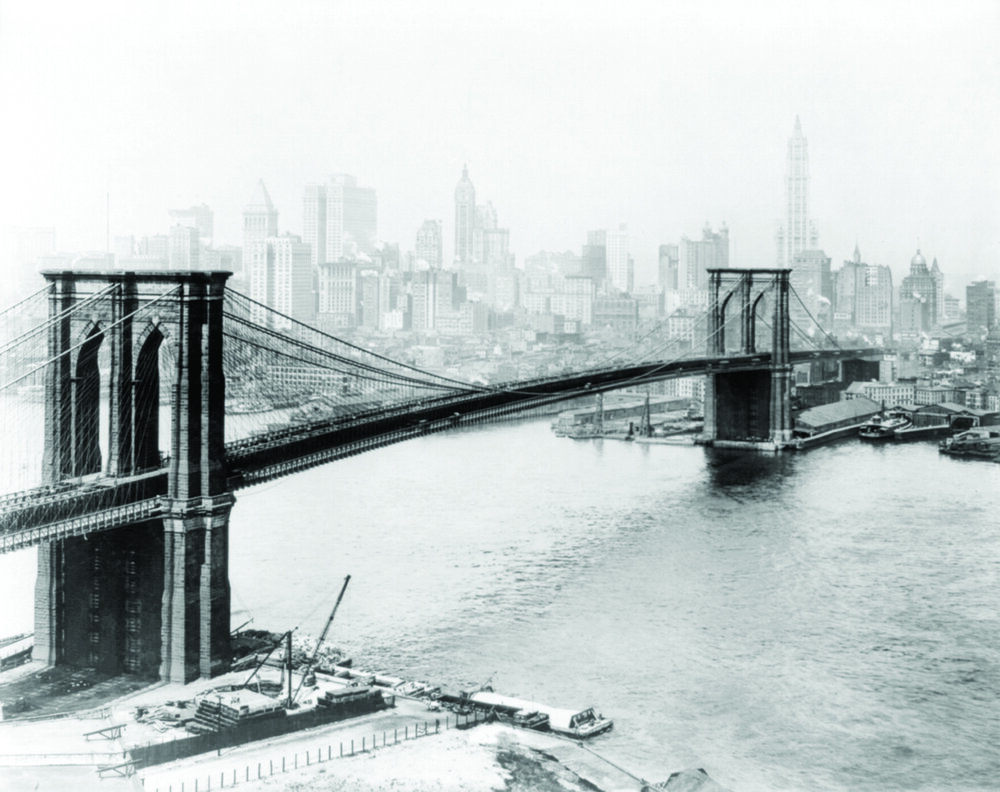“A Span, A Cry, An Ecstasy"
Posted by Edward Moran on Apr 12th 2020
If the Brooklyn Bridge were nothing more than an engineering marvel, that would have been enough to insure its place in the pantheon of great American civic enterprises. It was more than the sum of its cables and granite, though, for it became a potent symbol of American entrepreneurial spirit, idealized by poet and preacher alike. Like Upjohn’s Trinity Church at the foot of Wall Street, the Brooklyn Bridge had been executed in soaring Gothic motifs, but to more secular ends in what was then the Gilded Age. As the spires of Trinity soared heavenward, the Bridge’s arches offered Brooklynites greater opportunities to lay up treasures on earth; they were now given easier access to the stock exchanges and counting houses of Manhattan without having to navigate the East River by ferry, an especially daunting ordeal during the winters of the so-called “Little Ice Age” of the late 1800s.
Some forty years after Washington Roebling set down his telescope and vacated 110 Columbia Heights, a twentysomething poet rented a flat in the building -- John Dos Passos was also a resident there at the time -- and spent countless hours gazing at the bridge through his own poetic lens. His name was Hart Crane, the son of an Ohio candy maker who had recently patented ring-shaped peppermint lozenges later marketed as Life Savers. Ironic, because Crane would die several years later in a suicidal plunge from a steamer in the Gulf of Mexico. But not before imbibing the spirit of the Brooklyn Bridge from Roebling’s old perch, all while enjoying furtive trysts with sailors he often picked up in its shadows. Crane saw the bridge not only as a fertile cruising spot, but as liturgical vessels for his soul’s half-mystical, half-carnal communion with the sublime. As he writes, rhapsodically, with echoes of William Blake and Walt Whitman:
O harp and altar, of the fiery fused,
(How could mere toil align thy choiring strings!)
Terrific threshold of the prophet’s pledge,
Prayer of pariah, and the lover’s cry.
Crane was not the only poet to have been mesmerized by the Brooklyn Bridge. Marianne Moore, famously photographed under the Bridge’s arches by Richard Avedon in the 1960s, called it a “climactic ornament, a double rainbow” in her poem “Granite and Steel.” Moore’s protegée, Elizabeth Bishop, writing more whimsically, invited Moore to “please come flying” from Brooklyn over the Brooklyn Bridge “in the white mackerel sky” while “bearing a musical inaudible abacus/a slight censorious frown, and blue ribbons.”. Jack Kerouac added a 1950s Beat-and-Buddha sensibility to the mix with “The Brooklyn Bridge Blues as found in the Book of Dharmas”, written in hallucinatory cadences: "...John A Roebling/and Washington Roebling/built it, and it hath cables/and it does one good/to cross it everyday--/See my eerie wiseness?” Other writers of a more postmodern temperament have seen more dystopia than utopia in the bridge, but they are seldom read.
But it is perhaps Thomas Wolfe of “Only the Dead Know Brooklyn” fame who has captured the Bridge in all its incandescence (incidentally, the Bridge was one of the first public works to be strung with Edison’s new electric lights). Wolfe’s breathless paean is immortalized in a bronze plaque on a house he once occupied on nearby Montague Terrace: “Great God! the only bridge, the bridge of power, life and joy, the bridge that was a span, a cry, an ecstasy ... that was America.”[1]
[1] Goldstein, Norm. “Literary Brooklyn Heights,” August 15, 2012. Accessed May 22, 2016.





